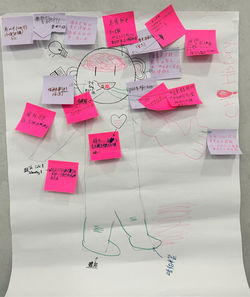
Participants' Sharing
The ceramic painting workshop was very interesting. I had the hands-on experience of colouring ceramics, which enhanced my understanding of ceramics.
I appreciated the interactive and hands-on components as they made the classes more engaging and enjoyable.
The guidance from the tutors helped us define the theme and the main idea. The programme was enjoyable, and the teaching stimulated our thinking.
I’m more into art stuff. I enjoy getting hands-on and crafting things during these sessions.
Question: Among all the learning activities in the 2nd Hong Kong Palace Museum Student Ambassador Programme, which activities do you consider the most rewarding or memorable?
Other organizations rarely offer artefact conservation workshop; it left a deep impression on me.
The hands-on experience of repairing broken bowls and learning restoration techniques was enriching.
I never thought of appreciating Chinese paintings and calligraphy from that perspective.
Learned so much in Mr Szeto's session of Chinese painting and calligraphy.
The explanations provided by the tutors during the docent skills training workshops were very clear; the information and advice they shared were extremely valuable.
“It’s Difficult to Be a Ruler” seal with stylised dragon.
The books read by the emperor.
The foliated bowl with floral scrolls. When making ceramic bowls, the bowls are usually placed upright. However, due to the large scale of production, ancient craftsmen chose to flip these foliated bowls upside down. This alone demonstrates the wisdom of ancient people.
Burnt and cracked porcelain, which was creatively turned into a brand new piece of art.
Fencai globular vase.
Which exhibits at the Museum impressed you the most?
What are the stories behind them? (Tertiary students)
The red dragon robe. Yellow dragon robes are seen more often than red ones. The nine dragons on the robe also symbolise the emperor's imperial presence.
The dragon robe.
The Qianlong Emperor's self-portrait, which is lively and playful.
Stories about the Buddha statues, which helped me understand the Qianlong Emperor's views on Buddhism.
A seal presented by Heshen as a gift for the Qianlong's birthday.
The porcelain imitation shell.
The exhibits which impressed me the most were the Tibetan Buddha statues. They display the Qing court’s religious diversity with interesting stories, such as the emperor deducting the artisans’ wages to cover the repair costs of the Buddha statues.
The painting the Qianlong Emperor gave to his mother, which took ten years to complete.
The crackles on porcelain wares made by the Guan kilns. The different degrees of expansion of the materials unexpectedly created the characteristics of Guan kiln porcelain, even elevating it to an art worthy of appreciation. This creation process is incredibly interesting to me.
So far, the activity that impressed me the most was the Imperial Three Low-fired Glazes Ceramic-making Workshop. It made me understand the difficulties in making ceramics and the need for patience and concentration. It was very interesting.
Making ceramics and learning to colour them. After learning about the history of ceramics, I am able to appreciate the art in a new way.
I had the most fun painting the pomegranate dish with dark dragon patterns! The metaverse has given me a lot of inspiration on how to combine the museum with technology!
Which activity of the Hong Kong Palace Museum Student Ambassador Programme has made the biggest impression on you so far?
(Tertiary students)
I would like to express my greatest gratitude to the organiser for bringing forth such wonderful activities! I was especially impressed by the ceramic painting experiences, which let me create my own art.
The ceramic painting experience. I gained a deeper understanding of the art of ceramics after learning the related concepts and techniques and colouring a ceramic piece myself.
The ceramic workshop, visiting a ceramic studio and painting ceramics.
The opening ceremony made the strongest impression on me and filled me with hope and enthusiasm. The curator’s speech also gave me a confidence boost and made me look forward to learning even more from this programme.
The introduction to exhibits related to Tibetan Buddhism.
The Qianlong Emperor ate hotpot 200 times a year.
A ceramic piece depicting children playing during the Qing dynasty.
The Qianlong Emperor’s stories about eating hotpot and drinking milk tea.
The bowls used by members of the royal family were all different.
The meaning of the patterns on the dragon robe.
Which exhibit left you with the strongest impression?
What exhibits are you interested in exploring further in terms of their history and culture? (Secondary school students)
Massage tool.
The architectural structure of the Forbidden City.
The Orchid Pavilion Collection.
Embroidery on clothes.
The story of the Qing Imperial Workshops.
The calligraphy scroll by Emperor Huizong of the Song dynasty, titled The Colour of the Sky after Rain.
“It’s Difficult to Be a Ruler” seal with stylised dragon.
The set of twelve-monthly flower cups.
The Forbidden City’s porcelain pieces, and I am interested in the Forbidden City’s religious activities and beliefs.
Ancient food and drink.
The books read by the emperor.
The cosmetic products used by imperial consorts.
A ceramic piece depicting children playing during the Qing dynasty.
What is the ambassadors’ idea of an excellent docent?
 |  |  |
|---|---|---|
 |  |  |
 |  |  |
 |  |  |
 |  |  |
 |  |
